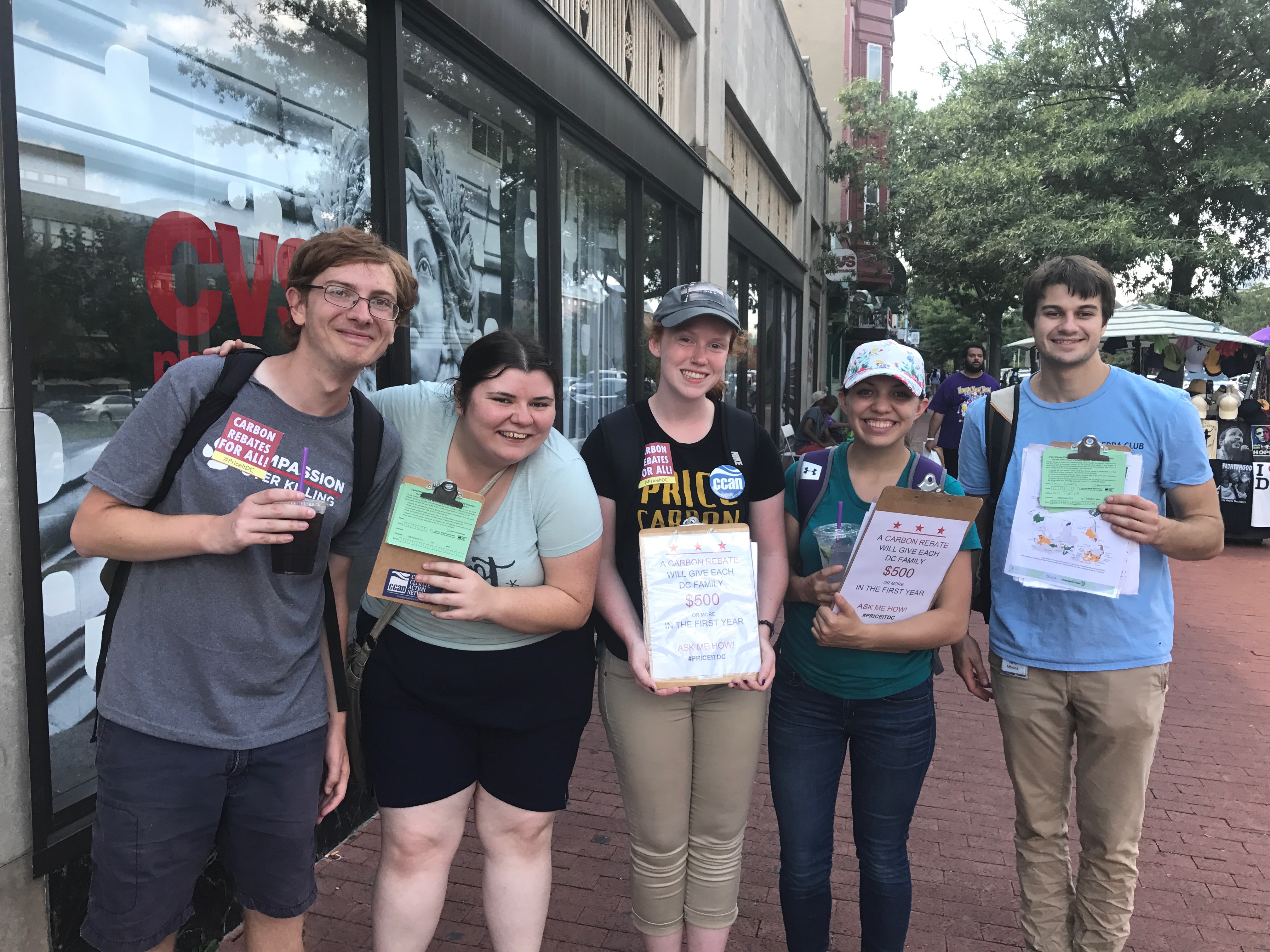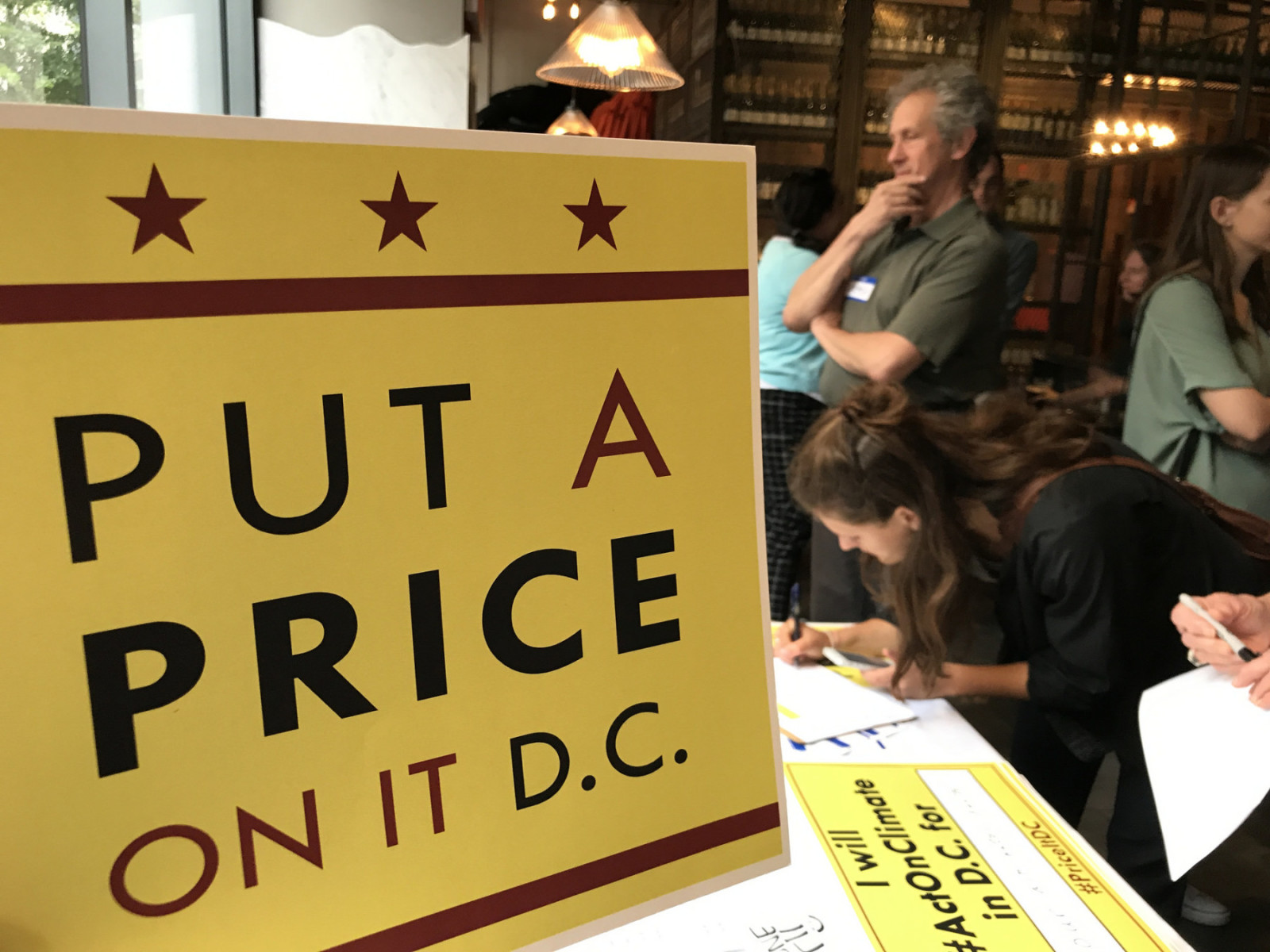What happens when you put four young college students and recent graduates together for a summer of organizing? You get a dynamic and versatile team of advocates with a strong pool of talents and interests, ranging from English to Environmental Policy, Economics, and Social Justice Organizing. I got to experience this phenomenon firsthand with Andrew, Maria, and Olivia, during my summer as one of the four interns working on the D.C. Put A Price On It campaign.
On a personal note, I moved to D.C. after spending a year in Vermont at graduate school and had very little experience in the city. Working on this campaign exposed me to a completely new level of D.C., outside of the traditional tourist attractions and historical monuments. I got to experience the authentic flavor of the District’s booming neighborhoods, many of which I had never heard of, nor visited before. It feels nearly impossible to dive into the details of what we all accomplished this summer, but I think it’s worth covering some of the most prominent highlights!
Our summer working on Put A Price On It D.C. was kickstarted with a visit to the John Wilson Building to do a lit drop of a Washington Post article that came out in support of carbon pricing as a climate solution. It provided a wonderful opportunity for us to meet some of the staffers and councilmembers face to face while pitching the campaign!
From that point, myself and the three other interns, Andrew, Maria, and Olivia took to the streets to educate residents about the policy by canvassing across the District. We talked to residents from across the city, including everyone from native Washingtonians to students attending university in D.C. Canvassing can be hard work at times, but I have to admit that some of the most memorable moments from the summer were from the time I spent talking to D.C. residents. I engaged in some of the most authentic and candid conversations with residents about climate change, justice, and the quirks of the city.
The tedious work of petitioning in the above average heat this summer was made more than worth it by the supportive words and thank yous we received from residents. By the end of the summer, we collected over 800 petitions from D.C. residents by visiting neighborhoods, metro stops, and attending events across the city.
Later in the summer, we gained practical advocacy experience by attending a public hearing with Council Member Cheh. I had the great pleasure of preparing and offering testimony at the hearing in support of the campaign, a first for me. It allowed me to apply my past education in communications and advocacy in a practical real world environment.
Overall, I’m proud of what we were able to accomplish over the past few months as interns on the D.C. campaign. Further, I’m excited to see where our futures take us. Something tells me that the four of us will cross paths in the future. It’s just the nature of this work! Successful advocates know that building lasting relationships is the key to powerful campaigns and coalitions. I hope that we’ll all be able to contribute to each other’s work in the future in one capacity or another. At the very least, we will all be able to look back on our summer as interns for the Price It D.C. campaign and reflect on the key advocacy and organizing skills we developed… And cheer with gusto when The Climate and Community Reinvestment Act is passed by the D.C. Council!
The Pursuit of Climate and Social Justice Through Carbon Pricing
What is environmental justice? According to the Environmental Protection Agency, it’s “the fair treatment and meaningful involvement of all people regardless of race, color, national origin, or income, with respect to the development, implementation, and enforcement of environmental laws, regulations, and policies.”
Unfortunately, the pursuit of environmental and social justice has been an uphill battle. Harmful environmental practices have taken place disproportionately in low-income communities of color for years — even decades — putting these communities on the front lines of pollution and climate change.
A prime example of this is gentrification of cities, which tailors to the tastes of the upper middle class and pushes low-income residents to the curb. Income inequality between the rich and poor looms as another related and potent issue. In the landmark report “Toxic Waste and Race in the United States,” it was found that race was the predicting factor for waste siting more frequently than income. To add another layer of complication, climate change threatens to exacerbate these issues of injustice.
This particularly concerning in the District of Columbia, one of the most clearly segregated cities in the United States, as highlighted by the Washington Post in 2015. Further, according to a report released by the D.C. Fiscal Policy Institute, income inequality in the District ranks fourth among the fifty largest cities in the United States. To break it down further, the richest 5 percent of Washingtonians make roughly fifty nine times what the poorest 20 percent make. Perhaps more relevant to this discussion, the study also found that D.C.’s lowest-income residents are primarily people of color.
It may come as no surprise that environmental and economic policies have the potential to become regressive, impacting lower income communities disproportionately. Developing policies that take justice issues into consideration is more important than ever. With this in mind, it is critical that the environmental policies that we pursue within the District serve all residents, regardless of race and socioeconomic status.
Luckily, the Healthy Community and Climate Reinvestment Act of D.C. plans to do just that by placing a fee on carbon emissions and rebating 75 percent of the collected revenue back to residents. At its core, this legislation is an effort to curb carbon emissions that contribute to global climate change. However, the fee and rebate model being employed has the potential to correct some other critical injustices occurring in the District as well. In particular, low income residents would see a rebate of about four dollars to every one dollar that they pay through the carbon fee, taking a step toward leveling the playing field between the highest and lowest income residents in D.C.
At the end of the day, climate change is the single issue that unites us all. Put A Price On It D.C.’s progressive approach to address climate change has a unique social justice flavor that is critical in today’s fight for a healthy climate and community.



